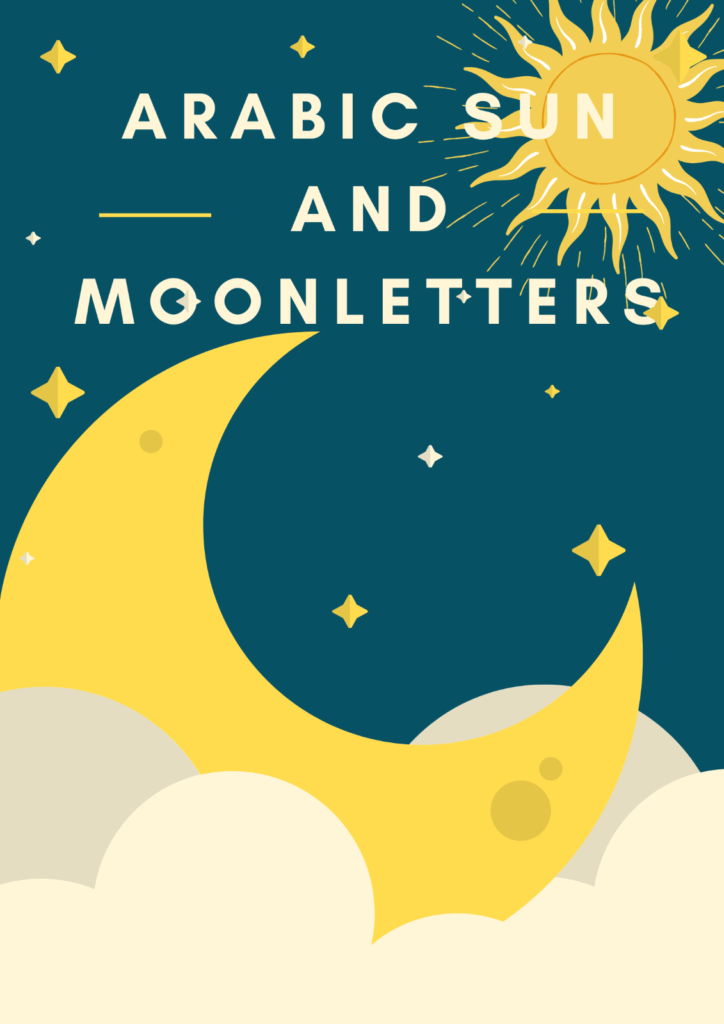Table of Contents
- 1 Sun and Moon letters in Arabic
- 2 What are Sun letters in Arabic?
- 3 Importance of sun letters in Arabic
- 4 What are the Moon Letters?
- 5 Why are they called moon letters?
- 6 Importance of moon letters in arabic
- 7 How are the Sun and moon letters pronounced with the definite article?
- 8 Practice the pronunciation
- 9 conclusion
- 10 FAQs
- 10.1 What are Sun and Moon letters in Arabic?
- 10.2 How many Sun letters are there in Arabic?
- 10.3 How many Moon letters are there in Arabic?
- 10.4 Why is it important to distinguish between Sun and Moon letters in Arabic?
- 10.5 How do moon letters affect the pronunciation of Arabic words?
- 10.6 How do you determine which letters are moon letters in Arabic?
Sun and Moon letters in Arabic
Many learners of the Holy Quran and Arabic find it difficult to distinguish between sun and moon letters and apply their rules while practicing the Arabic language and Quran recitation.
Arabic has a total of 28 letters, which are divided into 14 sun letters (الحروف الشمسية) and 14 moon letters (الحروف القمرية). Learning the difference and rules of pronouncing the words that contain the sun and moon letters is essential to perfecting your Arabic pronunciation and grammar.
The rule of sun and moon letters is very straightforward and simple. In this article, we will dive deep into the concept of sun and moon letters, their rules, and how to simplify them for better comprehension.
What are Sun letters in Arabic?
The 14 consonant Sun in Arabic Letters (الحُرُوفُ الشَّمْسِيَّةُ) in Arabic are pronounced differently depending on the letter that comes after them. These are the letters:
- ت (tā’)
- ث (thā’)
- د (dāl)
- ذ (dhāl)
- ر (rā’)
- ز (zāy)
- س (sīn)
- ش (shīn)
- ص (ṣād)
- ض (ḍād)
- ط (ṭā’)
- ظ (ẓā’)
- ل (lām)
- ن (nūn)
Why are they called Sun letters?
Let’s simplify the rules of the sun letter through its own Arabic term. In Arabic, the sun is called الشمس /Ash-Shams.
Can you pronounce it right?
It’s Ash-Shams.
And not Al-Shams.
Have you observed that laam (ل) is silent here?
The reason is simple. Whenever a word that starts with a sun letter meets the definite article, the laam in the definite article becomes silent while hamzatul wasl is pronounced. Sh or Arabic letter ش is one of the Sun letters.

Importance of sun letters in Arabic
The importance of sun letters in Arabic lies in the fact that they affect the pronunciation and spelling of words, as well as the way they are conjugated. For example, when a sun letter is followed by the definite article “al” (ال), the “l” sound assimilates with the sun letter and is pronounced as a double consonant. This is known as “إدغَام” (idgham).
Similarly, when a sun letter is used in the conjugation of verbs, it may undergo some changes depending on the tense and person. For example, in the present tense, the sun letters may cause the addition of an extra vowel sound (وَ) between the root letters and the conjugation suffixes.
Therefore, understanding the distinction between sun letters and moon letters is crucial for proper pronunciation and conjugation of Arabic words. It is considered an essential part of learning Arabic grammar and is taught in the early stages of Arabic language education.
What are the Moon Letters?
The remaining 14 consonant letters, known as the Moon Letters (الحُرُوفُ القَمَرِيَّةُ) are pronounced the same no matter what letter comes after them. These are the letters:
- أ (alif)
- ب (ba)
- ج (jim)
- ح (ha)
- خ (khaw)
- ع (ayn)
- غ (ghayn)
- ف (fa)
- ق (qaf)
- ك (kaf)
- م (mim)
- هـ (ha)
- و (waw)
- ي (ya)
A simple trick to memorize these words is to memorize the following rhyme that contains all the Moon-letters. All the remaining letters are sun letters.
ُاِبْغِ حَجَّكَ وَخَفْ عَقِيْمَه
(which roughly translates to: ‘Perform Haj and be vary of quarrel’).
Why are they called moon letters?
Moon letters are called الحُرُوفُ القَمَرِيَّةُ or “Huruf qamariyah”. They are called Moon letters because the definite article is pronounced with the word that starts with the moon letter (ق) and has no influence on the pronunciation of the hamzatul wasl or laam.
How do you pronounceالقَمر?
The correct pronunciation is Al-Qamr. Both hamzatul wasl and laam are pronounced here.
So there is no unique rule about pronouncing words that start with moon letters, as they are pronounced simply as usual.
Importance of moon letters in arabic
In Arabic grammar, there are two types of letters: sun letters (حُرُوفُ الشَّمْسِ) and moon letters (حُرُوفُ الْقَمَرِ). The distinction between sun letters and moon letters is important in the pronunciation and conjugation of Arabic words.
The importance of moon letters in Arabic is similar to that of sun letters. They affect the pronunciation and spelling of words, as well as the way they are conjugated. For example, when a moon letter is followed by the definite article “al” (ال), there is no assimilation or change in pronunciation.
In the conjugation of verbs, moon letters may also cause some changes depending on the tense and person. For example, in the past tense, the moon letters may cause the addition of an extra vowel sound (تَ) between the root letters and the conjugation suffixes.
Therefore, understanding the distinction between moon letters and sun letters is crucial for proper pronunciation and conjugation of Arabic words. It is considered an essential part of learning Arabic grammar and is taught in the early stages of Arabic language education.
How are the Sun and moon letters pronounced with the definite article?
Wants more explanation?
Here are examples of some words that we encounter while speaking Arabic language or reciting the holy Quran:
- شمس
- كتاب
When definite article (ال) combines with these words:
- Al-Shamsu ال + شَمس
- Al-Kitabu ال + كِتاب
As شمس starts with the letterش, which is a sun letter, therefore, the word is pronounced as Ash-shamsu (الشَّمس) and laam is silent here. Whereas the word كتاب starts with ك, which is a moon letter, therefore, there is no change in pronunciation and the word is correctly recited as Al-Kitab (الكتاب).
Practice the pronunciation
Practice the pronunciation of sun and moon letters with or without definite articles. After a few days, you won’t even have to think for a second to pronounce these words because you will become an expert at them.
You can use the following table to practice the letters.
| Sun Letters | Sun Words | Moon Letters | Moon Words |
| ت | تَمَرُّ | ب | بَابٌ |
| ث | ثَوْبٌ | ج | جَدٌّ |
| د | دَرَسَ | ح | حَصَلَ |
| ذ | ذَهَبَ | خ | خَيْرٌ |
| ر | رَسُولٌ | ف | فَتَاةٌ |
| ز | زَهْرَةٌ | ق | قَلَمٌ |
| س | سَمَكٌ | ك | كَرِيْمٌ |
| ش | شَمْسٌ | ل | لَيْلَةٌ |
| ص | صَلاَةٌ | م | مَسْجِدٌ |
| ض | ضَرْبَةٌ | ن | نَسِيْمٌ |
conclusion
Reading the Quran correctly is considered a great privilege and a source of immense blessings in Islam. The Quran is the holy book of Islam and is considered the word of God as revealed to the Prophet Muhammad (peace be upon him) through the Angel Gabriel. Therefore, reading the Quran with proper pronunciation and intonation is considered a way of showing respect and reverence for the word of God and is highly encouraged in Islam.
- Increased reward: Muslims believe that reading the Quran with proper Tajweed (rules of Quranic recitation) and understanding its meanings will earn them great rewards and blessings from Allah.
- Spiritual purification: Reciting the Quran with proper pronunciation and intonation is believed to have a purifying effect on the soul and to promote spiritual growth and development.
- Strengthening of faith: Reading the Quran with understanding and proper pronunciation can help Muslims deepen their faith and increase their connection with Allah.
- Protection from evil: Reciting the Quran with proper Tajweed is believed to have a protective effect against evil and to keep the reciter safe from harm.
- Intercession on the Day of Judgment: Muslims believe that those who read the Quran with proper Tajweed and understanding will be given a special status on the Day of Judgment and will be interceded for by the Quran itself.
In summary, reading the Quran correctly is considered a great privilege in Islam and is believed to bring numerous spiritual and worldly benefits. Muslims are encouraged to learn the rules of Quranic recitation and to strive to recite the Quran with proper pronunciation and understanding.
FAQs
What are Sun and Moon letters in Arabic?
Sun and moon letters are a group of arabic letters is pronounced depending differently depending on whether they are preceded by the definite article “al” (ال) or not.
How many Sun letters are there in Arabic?
There are 14 sun letters in Arabic: ﻥ ,ﻝ ,ﻅ ,ﻁ ,ﺽ ,ﺹ ,ﺵ ,ﺱ ,ﺯ ,ﺭ ,ﺫ ,ﺩ ,ﺙ ,ﺕ
How many Moon letters are there in Arabic?
There are 14 Moon letters in Arabic: ه ,ﻱ ,ﻭ ,ﻡ ,ﻙ ,ﻕ ,ﻑ ,ﻍ ,ﻉ ,ﺥ ,ﺡ ,ﺝ ,ﺏ ,أ
Why is it important to distinguish between Sun and Moon letters in Arabic?
It is important to distinguish between Sun and Moon letters in Arabic because it defines if the reciter or speaker should pronounce the definite article or not.
How do moon letters affect the pronunciation of Arabic words?
Moon letters in Arabic affect the pronunciation of words in a different way than sun letters. Moon letters are pronounced without a slight emission of breath (هَوَاءٌ) when they are followed by certain Arabic particles or pronouns, such as the definite article “al” (ال), the personal pronoun “huwa” (هُوَ), or the preposition “min” (مِنْ).
When a moon letter is followed by the definite article “al” (ال), there is no assimilation or change in pronunciation. For example, the word “bayt” (بَيْت) means “house,” and when the definite article “al” (ال) is added before it, it becomes “al-bayt” (الْبَيْت), with no change in pronunciation of the letter ب.
In contrast, when a sun letter is followed by the definite article “al” (ال), the “ل” sound assimilates with the sun letter and is pronounced as a double consonant. For example, the word “shams” (شمس) means “sun,” and when the definite article “al” (ال) is added before it, it becomes “ash-shams” (الشَّمس), with the letter ش pronounced as a double consonant.
Therefore, understanding the distinction between moon letters and sun letters is crucial for proper pronunciation of Arabic words, particularly when they are followed by certain particles or pronouns. It is important to learn and practice the correct pronunciation of both types of letters in order to speak Arabic accurately and fluently.
How do you determine which letters are moon letters in Arabic?
In Arabic grammar, there are two types of letters: sun letters (حُرُوفُ الشَّمْسِ) and moon letters (حُرُوفُ الْقَمَرِ). The distinction between sun letters and moon letters is important in the pronunciation and conjugation of Arabic words.
There is a simple rule to determine which letters are moon letters in Arabic: any letter that is not a sun letter is a moon letter. In other words, if a letter is not included in the list of sun letters, then it is a moon letter.
Here is the list of sun letters in Arabic:
ت، ث، د، ذ، ر، ز، س، ش، ص، ض، ط، ظ، ل، ن.
All other letters in the Arabic alphabet are moon letters. These include: أ ، ب، ج، ح، خ، ع، غ، ف، ق، ك، م، ه، و، ي.
It’s important to note that the distinction between sun letters and moon letters is not random but has historical and linguistic roots. The distinction is based on how these letters were pronounced in Classical Arabic and how they interact with certain particles and pronouns. Understanding the distinction between sun letters and moon letters is essential for proper pronunciation and conjugation of Arabic words.







